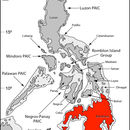en
names in breadcrumbs


For more detailed description of color (often from preserved specimens), see Brown and Alcala (1980).
(Coloration in preservative; Brown and Alcala, 1980)
Dorsal Coloration: brown to dark brown
Band/Stripe Coloration: usually with 7-9 narrow, irregular, incomplete to vaguely defined dark slate to blackish transverse bands
Ventral Coloration: ivory to light tan, underside of head and throat slate-brown to blackish brown
Of the 28 currently recognized species of skink in the genus Tropidophorus, four are recognized to occur in the Philippines (T. davaoensis, T. grayi, T. misaminius, and T. partelloi). Commonly referred to as Water or Keeled Skinks, this enigmatic radiation of Southeast Asian lizards consists of species that prefer habitat in and around stream and river systems.
In the Philippines, all four species are commonly observed underneath leaf litter, rocks, and collected piles of debris on the banks and in the middle of stream systems. Their unique morphologies make them easily identifiable in comparison to all other genera of Philippine lizards. Although variation in morphological characters has been documented between populations in the Philippines (Taylor, 1922), Brown and Alcala (1980) were the last to categorize and describe the country's diversity, recognizing only four species. The widespread species, T. grayi, exhibits large differences in adult body sizes between island populations, and likely includes multiple, unique evolutionary lineages in need of recognition.
There are only four recognized species of the genus Tropidophorus that are recongized to occur in the Philippines. Tripidophorus misaminius can be distinguished from its congeners by the following combination of characters: (1) keels on dorsal scales of body low, not terminating in projecting spines; (2) keels on dorsal scales of tail may or may not terminate in low projecting spines; (3) midbody scale rows 28-34; (4) scale rows between parietals and base of tail 44-50; (5) 4th toe lamellae 21-24; (6) frontonasal single; (7) parietals separate or rarely in contact behind interparietal; and (8) anterior loreal single scale (Brown and Alcala, 1980).
This species is recognized to occur on Basilan, Camiguin Sur, and Mindanao islands in the Philippines.
Mindanao Pleistocene Aggregate Island Complex (PAIC; Brown and Diesmos, 2002).
This species is often encountered under loose leaf litter and logs on the forest floor as well as along the banks of streams. Individuals are also encountered mid-streams beneath piles of leaves and branches that have collected in the middle of the stream. Other individuals have been collected within rotting logs on the forest floor. The species is recognized to occur in low to high-elevation forested habitat (350-1500 m; Brown and Alcala, 1980).
Reported to be ovoviviparous, with a single female observed to have three developed embryos in the uterus (Brown and Alcala, 1980).
SVL 89.7-112.2 mm (Brown and Alcala, 1980)
Malindang Mountain, Misamis Province, Mindanao Island, Philippines; type in the United States National Museum; USNM 37383
Tropidophorus misaminius, the Misamis waterside skink, is a species of skink. It is endemic to the Philippines, where it is found on several islands at elevations of 350 to 1500 m above sea level.[1] Its body is covered with pointed scales that likely deter predators. This species typically lives at the banks of streams and rivers and in forests, where they live under decayed logs. Near water they usually hide under rocks and warm up under the sun on those rocks when there is no danger around.[2]
Tropidophorus misaminius, the Misamis waterside skink, is a species of skink. It is endemic to the Philippines, where it is found on several islands at elevations of 350 to 1500 m above sea level. Its body is covered with pointed scales that likely deter predators. This species typically lives at the banks of streams and rivers and in forests, where they live under decayed logs. Near water they usually hide under rocks and warm up under the sun on those rocks when there is no danger around.